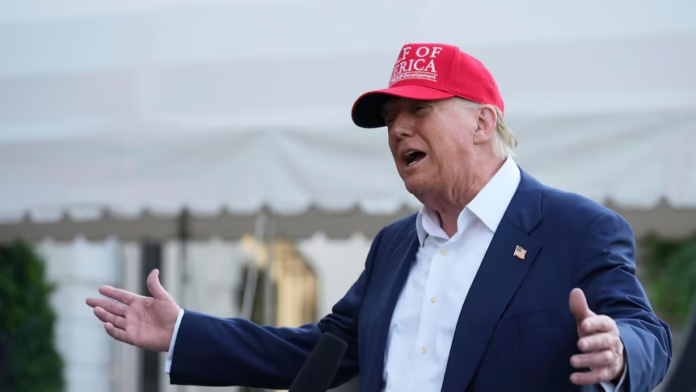The Big Beautiful Bill is nearly 900 pages long and includes tax breaks for middle- and high-income earners, while slashing social safety nets and expanding immigration enforcement
In a landmark move late on July 1, the U.S. Senate narrowly passed the Big Beautiful Bill, a massive legislative package pushed by former President Donald Trump. The key phrase—Big Beautiful Bill—has flooded political headlines, as this sweeping reform package reshapes taxes, welfare, immigration, and federal spending in one of the most controversial votes in recent American history.
Vice President J.D. Vance cast the tie-breaking vote in the Senate’s 51-50 decision, marking a dramatic climax to a 27-hour session filled with fiery debates, amendment battles, and last-minute changes. Now, the bill returns to the House for final approval, just in time for Trump’s goal to sign it by Independence Day.
Read For Updated Information : Big Beautiful Bill Summary: What It Means for Taxes, Social Security, and American Families
Key Points Summary of the Big Beautiful Bill
| Category | Highlights |
|---|---|
| Senate Vote Outcome | Passed 51-50 with VP J.D. Vance casting tie-break |
| Tax Provisions | Permanent 2017 tax cuts, overtime/tip deductions, SALT cap raised |
| Welfare Cuts | $900B cut from Medicaid, stricter SNAP eligibility |
| Immigration Enforcement | 10,000 new ICE agents, deportation quotas, detention expansion |
| Energy Shift | Clean energy credits reduced; fossil fuel investment boosted |
| Debt Projection | Estimated $2.7 trillion added over 10 years |
| Political Division | GOP split: 3 Republicans opposed; House pushback expected |
What the Big Beautiful Bill Contains
The Big Beautiful Bill is nearly 900 pages long and includes tax breaks for middle- and high-income earners, while slashing social safety nets and expanding immigration enforcement. At its core, the bill seeks to:
- Permanently extend most tax cuts introduced in 2017.
- Offer new deductions for overtime pay, tip income, car loan interest, and senior citizens.
- Raise the State and Local Tax (SALT) deduction cap from $10,000 to $40,000 temporarily.
- Slash $900 billion from Medicaid, imposing stricter eligibility and work requirements.
- Restrict SNAP (food stamp) benefits through tighter income and asset testing.
- Repeal large portions of green energy incentives while redirecting funding to fossil fuels.
- Expand immigration control with quotas, detention centers, and 10,000 new ICE agents.
- Increase defense spending, particularly for border infrastructure and surveillance.
Big Beautiful Bill Sparks Immediate Controversy
The passage of the Big Beautiful Bill has ignited a storm of responses across the political spectrum:
- Fiscal watchdogs warn the bill will increase the national deficit by over $2.5 trillion over the next decade, largely due to the permanent extension of tax breaks.
- Healthcare advocates say the Medicaid cuts could force 10 to 12 million Americans off coverage by 2034, hitting nursing homes and low-income families hardest.
- Environmental groups have condemned the rollback of clean energy incentives, saying it could reverse recent climate gains and raise long-term energy costs.
- Immigrant rights activists argue that the expansion of ICE and deportation quotas risks violating civil liberties and flooding already burdened detention centers.
Meanwhile, social media exploded with mixed reactions. While Trump supporters hailed the bill as a return to “America First” principles, critics dubbed it the “Big Brutal Bill” due to its sweeping cuts to public assistance programs.
Read Also-Did the Big Beautiful Bill Pass? Latest Developments and What’s Next
Internal GOP Division: Not All Republicans Backed It
Although the bill passed the Senate, cracks within the Republican Party became obvious:
- Senators Susan Collins, Thom Tillis, and Rand Paul voted against the bill, citing concerns over Medicaid cuts, fiscal irresponsibility, and overreach in immigration policy.
- Senator Lisa Murkowski flipped to support after winning specific exemptions for Alaska’s energy sector and tribal programs.
- In the House, Republicans like Andy Biggs and Chip Roy have demanded amendments before agreeing to final passage, warning that rushing it through could hurt the party in upcoming elections.
Despite these fractures, House Speaker Mike Johnson has pledged to bring the bill to a vote within days, aiming to deliver a legislative win before the July 4 deadline.
What Happens If the House Fails to Pass the Bill?
If the House fails to pass the Big Beautiful Bill in its current form, it could return to a conference committee, delaying progress indefinitely. Such a scenario could:
- Undermine Trump’s momentum heading into the election season.
- Divide the GOP further at a time when party unity is essential.
- Fuel public criticism, especially from those already anxious about healthcare, food security, and immigration.
With Democrats uniformly opposed, the pressure is now on moderate Republicans to either back the bill or demand key changes—many of which could unravel the delicate coalition that enabled its Senate passage.
Public Sentiment and Election-Year Risks
Polls taken immediately after the Senate vote suggest:
- 50% of Americans oppose the bill,
- 36% support it, and
- 14% remain undecided.
The most unpopular components include Medicaid cuts, expanded ICE powers, and environmental rollbacks. These numbers present a major challenge for GOP candidates in swing districts who must now defend their support—or opposition—to a bill that touches nearly every aspect of American life.
Final Word: Big Beautiful Bill’s Next Chapter
The Big Beautiful Bill is more than just legislation—it’s a political statement, a campaign platform, and a test of unity for the Republican Party. With its Senate passage, Trump has inched closer to one of his biggest policy victories yet. But with strong internal dissent and mounting public concern, the road ahead remains uncertain.
Whether this bill becomes law or stalls in the House, one thing is certain—it will be a defining issue for the remainder of 2025 and beyond.
Now is the time to stay informed. Follow the House developments closely. Share this article with your community and engage with your local representatives. What happens next will affect every American household.
